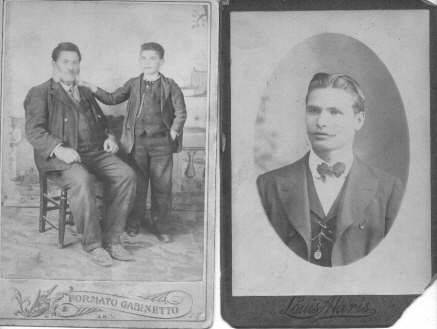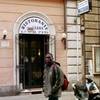Racism/Razzismo Part III: Lest We Forget: Racism Will Make Victims of Us All
It was the second article I wrote for The Brooklyn Free Press after it became increasingly obvious to me that The Media had decided to make the “Italian” aspect of the murder of Yusuf Hawkins, and the neighborhood's reaction to provocative marches through the community, a continuing story. The Italian versus Black “angle” tied in nicely to the fact that Italian-American Rudolph Giuliani, a Republican, was preparing to face African-American David Dinkins, a Democrat, in the upcoming New York City general election for Mayor that November. I felt it was necessary to express in my own writing and in my subsequent interviews with the media not only the non-ethnic aspects of the homicide but also the common experiences of all of America’s minorities as exemplified in the infamous lynching of eleven Italian Americans in New Orleans almost a century earlier. As indicated by George De Stefano's recent op-ed here in i-italy "Italians are Better Than This," Italians could also benefit by reviewing their own history as victims as well as victimizers. Tomorrow I leave for Berlin to participate in a conference on "Migration in Museums - Narratives of Diversity in Europe," in order to learn more about what's going on "there" and perhaps get a chance to share what is going on "here."
* * *
On August 23, 1989 an African-American man by the name of Yusuf Hawkins was murdered in a predominately Italian neighborhood in Brooklyn. He was killed by a person, or persons, who were part of a mob of young men who some excuse because they acted in defense of their “turf.” Since this racist murder by a monstrous few has taken place, the wider racism and bigotry of the society at large has been prominently, and at times proudly, displayed. It was not unlike a lynching-murder by a hateful mob. It was not the first. Let’s try to make it the last.
Not unexpectedly many of those who are most responsible for the problems in our social and physical environment—our political leaders—have absolved themselves of guilt for the generally hostile intergroup climate in our city. Our politicians now claim they have been “unifiers”; their opponents have been the “dividers.” Editorialists and academics have done their part by blaming a particular neighborhood (Bensonhurst) or a particular ethnic group (Italian-Americans). In effect scapegoating working-class ethnics for the continued discrimination and episodic violence against nonwhite Americans.
As a sociologist and “expert” on urban affairs I was quoted in the papers and appeared on television explaining how the centuries-old Southern Italian culture of family and village defense makes Italian-American neighborhoods especially suspicious and fearful of outsiders. In every case however I emphasized that such communities are by no means more racist or discriminatory than any other “American” community. In working-class, white ethnic enclaves battles to keep “them” out of the neighborhood are just, more likely to be fought in the street by residents. Other, more advantaged, people for example use co-op boards or “color-blind” economic criteria and rely on private security and closed circuit television for protection against those they don’t like. Pitting people who should be working together, against each other is a long-standing American tradition. Putting the blame on Italian Americans for American racism is not unlike blaming Irish Americans for anti-Catholicism or Jews for anti-Semitism.
Not too long ago—and to many, still today—Italians (especially Southern Italians) were (are) considered members of an inferior race. The idiots who held up watermelons while black protestors marched near the site of Hawkins death haven’t the faintest idea that watermelons, racism and Southern Italians have a lot in common.
First of all my grandfather, from Palermo, Sicily, Gerolimo Cangelosi worked his way up from selling watermelon by the slice on New York City street corners and had to endure the anti-Italian bias of America society. Being a victim, however, gives no one a right to victimize others.Recently, Assemblyman Frank Barbaro led a contingent of Italian-American community leaders and members of FIERI, an Italian American student group, who met with a group of African-American protest marchers at the site of Yusuf Hawkins murder as part of what should be a continuing dialogue. Barbaro and others have courageously spoken out against the violence committed by a small minority in the community and stand in marked contrast to the silent embarrassment and sympathy of a much larger group of local residents.
The difference between those who speak out and those who are silent is that, like the members of FIERI, those Italian-Americans who confront and try to correct the problems in their own community rather than ignore or deny them are proudly aware of their own group’s suffering as well as their accomplishments and heritage. They know that Italians are not simply racist guidos and mafia dons and they know that Italians, as many other “Euro-American” immigrants were the victims of poverty and the focus of racist attention in past decades.
Parallels between the African-American and Italian-American experiences are numerous and should be the source of cooperation rather than conflict. All of the historical events that follow should seem familiar to the reader, as they are the plagues visited upon wave after wave of poor American migrants and immigrants. In 1906, speaking on “The Immigration Problem” Robert DeCourcy Ward warned that Slavs, Italians and Jews because of their high birth rates would “degrade” the “American race.” Other contemporary critics of Southern Italian immigration warned that Italians were a threat to America because they were not “white.” In fact it has been argued by some experts that the epithet “guinea” was “derived from a name attached to slaves from part of the western African coast.” The poverty of Southern Italy was so great during the latter part of the 19th Century that a transoceanic traffic was created for “Italian Slave Children.” The New York Herald reported on one of many “raids” on Italian padrones who either through contractual arrangements with parents or kidnapping sent hordes of juvenile minstrels out to beg in the streets of New York and Philadelphia. In one cellar “home” for the children the police and reporters found “an abominable place, the breeding ground of disease and the abode of roaches and vermin.” In 1870 there was a “Riot in Mamaroneck.” Irish and Italian laborers clashed over jobs. The end result of the battle as reported in the New York Sun was: “The Italian population of Grand Park was Driven Out—The Women and Children Sheltered in the Town Hall of Morrisania—Our Home War of Races.”
In many cases Italian laborers were paid lower wages than “native whites” or “negroes,” making them more desirable employees. This fact of life was the justification for many riots against Italian workers who also were eager to work as “scabs” during strikes. Poor Southern Italian peasants were viewed by Dixie plantation owners as potential replacements for freed black slaves. The Italian government even cooperated in several “experiments” at population transfers that were unsuccessful.
The major problem for the plantation owners was that Italian peasants were too difficult to control. Late nineteenth- and early twentieth-century American press accounts and descriptions of Italians conveyed the message that “dagoes” were “dangerous,” “lazy,” “filthy,” “cruel,” “ferocious,” and bloodthirsty.” One Irish-American critic in the 1880s noted that “The Italian was all too ready to ask for public assistance.” And that the absence of “manly qualities” separated the Italian immigrants from others in America. As with African Americans, the best indicator of racial hatred is the American custom of “lynching.”
Although there are many incidents of Italians being lynched by racist mobs, the most (in)famous took place in New Orleans on March 14, 1891 when, related by historian Patrick Gallo: “a mob of 6,000–8,000 people, led by prominent citizens, descended on the parish jail to get the “Dagoes.” State and local law officers, and the governor who was in the city at the time, stood by and did nothing, the mob hanged two of the suspects from lampposts, and lined nine of them up in front of the prison wall and blasted their bodies with rifles, pistols, and shotguns, taking less than twenty minutes for their grim work.” The victims of the mob had been accused of killing the New Orleans superintendent of Police whose dying words were “The Dagoes shot me . . . the Dagoes did it.” He did not recognize his killers. Neither did any other witnesses. The Mayor of New Orleans therefore ordered the police “to arrest every Italian you come across.” About 150 were arrested. When the courts began to find them innocent, the New Orleans Times-Democrat called for “All good citizens . . . to attend a mass meeting . . . to take steps to remedy the failure of justice,” resulting in the largest mass lynching in American history.
Reactions to the lynchings were as good as could be expected considering the general stereotype of Italians. Theodore Roosevelt considered the lynching of eleven “rather a good thing” and the New York Times agreed that “the Lynch Law was the only course open to the people of New Orleans.” To preserve American honor President Benjamin Harrison apologized to the Italian government for the slaughter of these and other Italians in America and gave a $25,000 indemnity to the families of 18 victims. I imagine that some poor Italian back in the 1890s, maybe even my grandfather, when he read about the lynchings, shivered and prayed that racial violence would someday end.
Works Cited:
Freeman, Robert C. “The Development and Maintenance of New York City’s Italian American Neighborhoods.” The Melting Pot and Beyond: Italian Americans in the Year 2000. Ed. Jerome Krase and William Egelman. Staten Island: American Italian Historical Association, 1987. 223–35.
Gallo, Patrick J. Old Bread, New Wine. Chicago: Nelson Hall, 1981.
Krase, Jerome “The Italian American Community: An Essay on Multiple Social Realities.” The Family and Community Life of Italian Americans. Ed. Richard N. Giuliani. Staten Island: American Italian Historical Association, 1983. 95–108.
La Gumina, Salvatore J. WOP: A Documentary History of Anti-Italian Discrimination in the United States. San Francisco: Straight Arrow Books, 1973.
By Jerry Krase, The Brooklyn Free Press, September 22, 1989.









































i-Italy
Facebook
Google+
This work may not be reproduced, in whole or in part, without prior written permission.
Questo lavoro non può essere riprodotto, in tutto o in parte, senza permesso scritto.